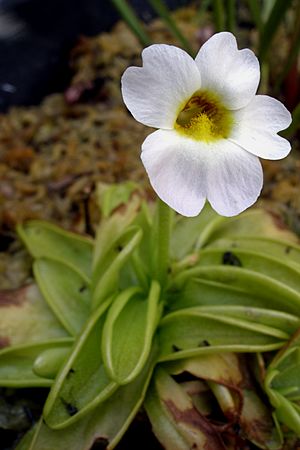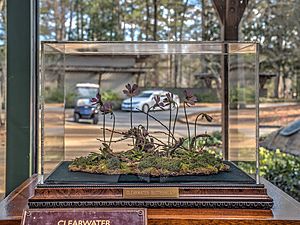Pinguicula primuliflora facts for kids
Quick facts for kids Pinguicula primuliflora |
|
|---|---|
 |
|
| Scientific classification | |
| Genus: |
Pinguicula
|
| Species: |
primuliflora
|
| Synonyms | |
|
|
The Pinguicula primuliflora, also known as the southern butterwort or primrose butterwort, is a special type of carnivorous plant. It grows naturally in the southeastern United States. When it blooms, it usually has a pretty white flower.
Like other butterwort plants, its leaves are sticky. These sticky leaves help the plant catch and eat small insects. This is how the plant gets important nutrients, like nitrogen, that are missing from the poor, acidic soil where it lives. Its name, "primrose butterwort," comes from the fact that it's often one of the first plants to flower in the spring.
Contents
How It Eats Insects
Pinguicula primuliflora is a carnivorous plant, just like all plants in the Lentibulariaceae family. Its leaves are covered with tiny hairs. These hairs make a sticky liquid, which makes the leaves look wet. This wet look might trick insects into thinking it's water.
When an insect lands on a leaf, it gets stuck in the sticky liquid. As the insect tries to escape, it gets even more covered in the goo. Then, the plant releases special juices that break down the insect's body. The plant then soaks up these nutrients, which act like food. The leaves of P. primuliflora are usually green.
Roots and How They Work
Like all Pinguicula plants, the roots of the southern butterwort are not very big. Their main jobs are to soak up water and to hold the plant firmly in the ground. Unlike most plants, Pinguicula primuliflora gets its food and nutrients by eating insects, not through its roots.
Flowers and Reproduction
Pinguicula primuliflora has flowers with five petals. These flowers are zygomorphic, meaning they have a special shape that is symmetrical in only one way, like a face. The plant can fertilize itself, but it still needs to be pollinated for seeds to form. This means something, like an insect, needs to move pollen from one part of the flower to another.
Growing This Plant
The Pinguicula primuliflora is a great choice for beginners who want to grow a butterwort. It's usually easy to care for. It doesn't need super high humidity or extremely bright light to grow its sticky, insect-catching leaves and produce flowers.
You can grow new plants from seeds, or even better, by cross-pollinating it with another plant. This plant can grow very well, sometimes even spreading out with many new shoots that might fill up its pot.
To grow P. primuliflora, you need the right kind of soil, just like for other carnivorous plants. It needs poor, acidic soil without much nutrients. A good mix is half peat moss and half perlite or horticultural sand. You can also use pure sphagnum peat moss. Never use regular potting soil or fertilizer.
Some butterworts, including P. primuliflora, can be grown in a tray of standing water. This helps keep the soil moist and increases the humidity around the plant.
Where It Lives

The Pinguicula primuliflora plant is found naturally in the southeastern United States. You can commonly find them from the southern part of Mississippi to the northwestern part of Florida. They live in Zone 8 of the USA. These plants can handle short periods of cold weather, down to about 20 degrees Fahrenheit (-9 degrees Celsius), during their resting period, which usually lasts 3 to 4 months.

